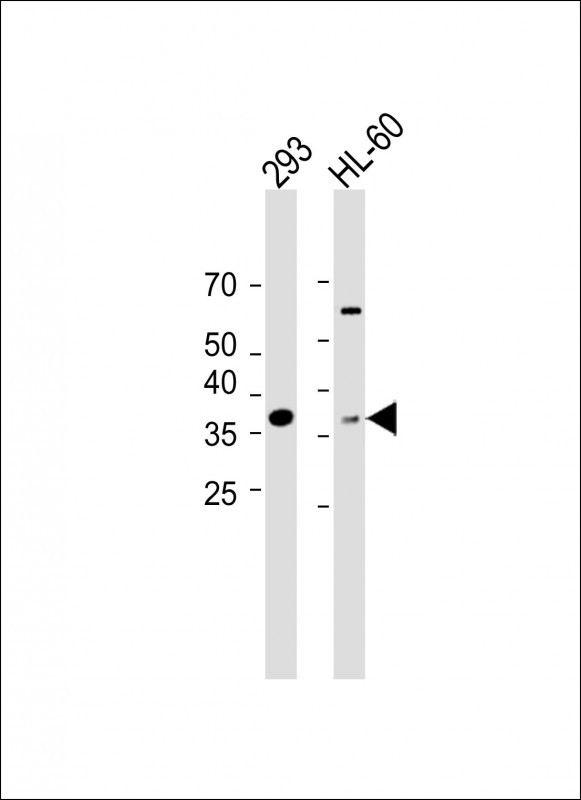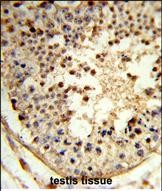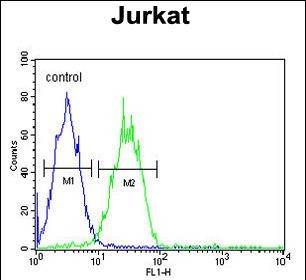ARGLU1 Antibody (N-term)
Affinity Purified Rabbit Polyclonal Antibody (Pab)
- 产品详情
- 实验流程
- 背景知识
Application
| WB, IHC-P, FC, E |
|---|---|
| Primary Accession | Q9NWB6 |
| Other Accession | Q2TA42 |
| Reactivity | Human |
| Predicted | Bovine |
| Host | Rabbit |
| Clonality | Polyclonal |
| Isotype | Rabbit IgG |
| Calculated MW | 33216 Da |
| Antigen Region | 48-74 aa |
| Gene ID | 55082 |
|---|---|
| Other Names | Arginine and glutamate-rich protein 1, ARGLU1 |
| Target/Specificity | This ARGLU1 antibody is generated from rabbits immunized with a KLH conjugated synthetic peptide between 48-74 amino acids from the N-terminal region of human ARGLU1. |
| Dilution | WB~~1:1000 IHC-P~~1:100~500 FC~~1:10~50 E~~Use at an assay dependent concentration. |
| Format | Purified polyclonal antibody supplied in PBS with 0.05% (V/V) Proclin 300. This antibody is purified through a protein A column, followed by peptide affinity purification. |
| Storage | Maintain refrigerated at 2-8°C for up to 2 weeks. For long term storage store at -20°C in small aliquots to prevent freeze-thaw cycles. |
| Precautions | ARGLU1 Antibody (N-term) is for research use only and not for use in diagnostic or therapeutic procedures. |
| Name | ARGLU1 |
|---|---|
| Function | Dual function regulator of gene expression; regulator of transcription and modulator of alternative splicing (PubMed:30698747). General coactivator of nuclear receptor-induced gene expression, including genes activated by the glucocorticoid receptor NR3C1 (PubMed:30698747). Binds to a subset of pre-mRNAs and to components of the spliceosome machinery to directly modulate basal alternative splicing; involved in simple and complex cassette exon splicing events (PubMed:30698747). Binds its own pre-mRNA and regulates its alternative splicing and degradation; one of the alternatively spliced products is a stable intronic sequence RNA (sisRNA) that binds the protein to regulate its ability to affect splicing (PubMed:27899669, PubMed:36533631). Binding of the sisRNA stimulates phase separation and localization to nuclear speckles, which may contribute to activation of nuclear receptor-induced gene expression (PubMed:36533631). May also indirectly modulate alternative splicing (PubMed:30698747). Regulates transcription of genes involved in heart development, neuronal cell function, protein localization and chromatin localization (By similarity). Regulates splicing of genes involved in neurogenesis and chromatin organization (By similarity). Essential for central nervous system development (By similarity). Required for the estrogen-dependent expression of ESR1 target genes (PubMed:21454576). Can act in cooperation with MED1 (PubMed:21454576). |
| Cellular Location | Nucleus. Nucleus speckle. Chromosome. Note=Recruited, in an estrogen-dependent manner, to ESR1 target gene promoters (PubMed:21454576). Colocalizes with MED1 in nuclear speckles (PubMed:21454576, PubMed:36533631) Binding of sisRNA promotes phase separation and localization to nuclear speckles (PubMed:36533631). Associated with glucocorticoid response elements of target genes, even in the absence of glucocorticoid receptor ligands (By similarity). {ECO:0000250|UniProtKB:Q3UL36, ECO:0000269|PubMed:21454576, ECO:0000269|PubMed:36533631} |
Research Areas
For Research Use Only. Not For Use In Diagnostic Procedures.
Application Protocols
Provided below are standard protocols that you may find useful for product applications.
BACKGROUND
ARGLU1 belongs to the UPF0430 family. There are two named isoforms.
REFERENCES
Olsen,J.V., et.al., Cell 127 (3), 635-648 (2006)
Beausoleil,S.A., et.al., Proc. Natl. Acad. Sci. U.S.A. 101 (33), 12130-12135 (2004)
Beausoleil,S.A., et.al., Proc. Natl. Acad. Sci. U.S.A. 101 (33), 12130-12135 (2004)
终于等到您。ABCEPTA(百远生物)抗体产品。
点击下方“我要评价 ”按钮提交您的反馈信息,您的反馈和评价是我们最宝贵的财富之一,
我们将在1-3个工作日内处理您的反馈信息。
如有疑问,联系:0512-88856768 tech-china@abcepta.com.























 癌症的基本特征包括细胞增殖、血管生成、迁移、凋亡逃避机制和细胞永生等。找到癌症发生过程中这些通路的关键标记物和对应的抗体用于检测至关重要。
癌症的基本特征包括细胞增殖、血管生成、迁移、凋亡逃避机制和细胞永生等。找到癌症发生过程中这些通路的关键标记物和对应的抗体用于检测至关重要。 为您推荐一个泛素化位点预测神器——泛素化分析工具,可以为您的蛋白的泛素化位点作出预测和评分。
为您推荐一个泛素化位点预测神器——泛素化分析工具,可以为您的蛋白的泛素化位点作出预测和评分。 细胞自噬受体图形绘图工具为你的蛋白的细胞受体结合位点作出预测和评分,识别结合到自噬通路中的蛋白是非常重要的,便于让我们理解自噬在正常生理、病理过程中的作用,如发育、细胞分化、神经退化性疾病、压力条件下、感染和癌症。
细胞自噬受体图形绘图工具为你的蛋白的细胞受体结合位点作出预测和评分,识别结合到自噬通路中的蛋白是非常重要的,便于让我们理解自噬在正常生理、病理过程中的作用,如发育、细胞分化、神经退化性疾病、压力条件下、感染和癌症。








